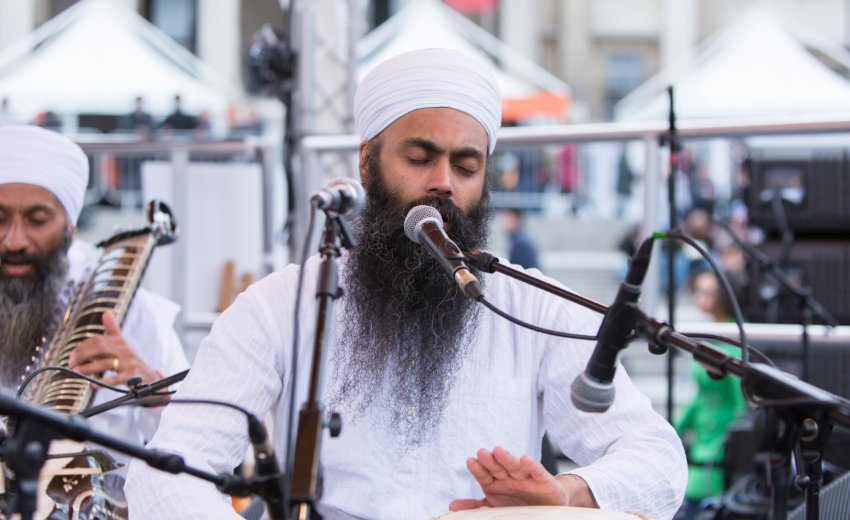In 2009, a heartwarming video surfaced showing a group of Sikh children in Fremont, California, learning the art of kirtan in classical raags. This video shed light on the wonderful tradition of kirtan being passed down to the younger generation of Sikh musicians. It's heartening to witness these young talents embracing classical music, mastering ancient stringed instruments, and performing kirtan within the rich framework of Classical or raag music.
The growth of this musical tradition has become increasingly evident in recent years. Notably, institutions like The Raj Academy in Great Britain and the Gurmat Sangeet Department at Punjabi University Patiala have emerged, specializing in providing traditional instruction in kirtan. Additionally, the Miri Piri Academy in Amritsar has played a significant role in nurturing this musical heritage, giving rise to the Chardi Kala Jatha—a group of classically trained Sikh musicians who happen to be of American nationality. These developments showcase the enduring appeal and relevance of kirtan in the modern world while preserving its deep-rooted classical essence.
Gurmat Sangeet
Sikh music, also known as Gurbani Sangeet, Gurmat Sangeet, or Shabad Kirtan, is a cherished musical tradition within Sikhism. It encompasses a rich tapestry of melodies, styles, and performances, thriving in various forms, from the formal to the folk. Within the Sikh musical community, you'll find three key types of musicians: rababis, ragis, and dhadhis. This music flourishes in a diverse range of melodic modes and performance contexts, reflecting the vibrant essence of Sikh culture.
While the term Gurmat Sangeet is often used to describe all Sikh kirtan performed in line with the prescribed ragas from Sikh scriptures, some experts suggest a more precise name for the raga genre could be "rāg-ādhārit shabad kīrtan." Additionally, there is a belief that the broader field of Sikh musicology should be referred to as "gurmat sangīt shāstra/vigyān," within which raga kirtan holds a significant place. This tradition continues to thrive and evolve, resonating with the spiritual and cultural values of the Sikh community.
Historical significance
Musical expression has always held a special place in the Sikh tradition, dating back to the time of Guru Nanak Dev Ji and his close companion, Bhai Mardana. This connection between music and Sikhism is evident in historical texts like the Janamsakhis and Bhai Gurdas's Varan. Additionally, various 18th and 19th-century paintings depict Guru Nanak Dev Ji singing while Mardana plays his instrument, showcasing their musical devotion.
Bhai Mardana, proficient in playing the rabab (a plucked lute), would accompany Guru Nanak on his journeys, providing a melodic backdrop to Nanak's teachings. This partnership is credited with establishing the rababi tradition within Sikhism. Whenever Guru Nanak received divine inspiration, he would call out, "Mardaneya! Rabab chhed, bani aayee hai" (Mardana, play the rabab, divine verses have come to me), highlighting the integral role of music in conveying spiritual messages.
After Guru Nanak Dev Ji established Kartarpur, his home, he and his companion Mardana created beautiful verses set to music, and these were written down in various pothis (manuscripts). One of these precious texts, known as the Guru Harsahai Pothi, claims to contain these early compositions. During Guru Nanak Dev Ji’s time, the prevailing musical style was dhrupad and dhamar, which left its mark on Sikh music. Later on, other musical traditions like khayal, tappa, and qawwali began to influence Sikh musical expressions.
After Guru Nanak Dev Ji, his successors continued to develop Sikh music. Guru Angad, the second guru, introduced the practice of singing the Āsā kī Vār ("Ballad of Hope") in the early morning as a form of devotion. Guru Amar Das Ji, the third guru, formalized the tradition of concluding kirtan performances with the Ānand ("Bliss") composition. Guru Ram Das Ji, the fourth guru, incorporated the Lāvāṅ verses into Sikh wedding ceremonies, making them a central part of the celebration. This rich history of musical evolution within Sikhism has added vibrant colours and flavors to this spiritual tradition.
In Sikh tradition, Guru Arjan Ji is known for playing the sarandā and creating the upright jọṛī from the mridang. He also compiled the Adi Granth, the precursor to the Guru Granth Sahib, a vital source for Sikh music. Guru Arjan Ji introduced the practice of having five kirtan sessions at the Harmandir Sahib shrine in Amritsar, making a significant impact on Sikh musical tradition.
Revival of the traditional forms
In the 1930s-'40s, the Sikh Reht Maryada movement took the first step in bringing back authentic Sikh musical traditions and preserving historical instruments, rhythms, and styles. In the 1970s, Jagjit Singh, a Namdhari leader, also made efforts to revive these traditions, imparting traditional Gurmat Sangeet training to many young enthusiasts at Bhaini Sahib. Another significant push for Sikh traditional music revival occurred in 1991 during the Adutti Gurmat Sangeet Sammellan held at Gurdwara Gur Gian Prakash, or the Jawwadi Taksal, in Ludhiana.
In recent times, Khalsa Schools and private groups have been giving more importance to teaching young Sikhs the art of kirtan in raag and playing traditional Indian and Sikh musical instruments. This is truly wonderful, as it means that the current and future generations of Sikhs have the chance and the enthusiasm to learn Gurbani alongside Gurmat Sangeet, the way the Gurus intended it to be.
*Based on an article published in thelangarhall.com on 4th March 2009

